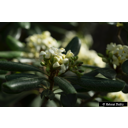Wissenswertes zum Taxon (Art, Unterart, Varietät...)
Pittosporum tobira (Thunb.) W. T. Aiton 1811
Pittosporaceae
- Klebsamengewächse (APG IV)Chinesischer Klebsame, Pechsame
Taxonkonzept: The Plant List (2010)
Verbreitung: China, Südkorea, Japan
Größe: 0 (m)
Blütezeit: III - IV
Pittosporum tobira (Thunb. ex Murray) W. T. Aiton - Accepted: Pittosporum tobira (Thunb. ex Murray) W. T. Aiton bei Zander 2008; Familie: Pittosporaceae (Zander 2008)Pittosporum tobira (Thunb. ex Murray) W. T. Aiton - Synonym: Pittosporum tobira (Thunb.) W. T. Aiton bei The Plant List (2010); Familie: Pittosporaceae (APG III)Pittosporum tobira (Thunb.) W. T. Aiton - Accepted: Pittosporum tobira (Thunb.) W. T. Aiton bei The Plant List (2010); Familie: Pittosporaceae (APG III)Pittosporum tobira (Thunb.) W. T. Aiton - Accepted: Pittosporum tobira (Thunb.) W. T. Aiton bei The Plant List (2014), version 1.1; Familie: Pittosporaceae (APG III)Pittosporum tobira (Thunb.) W. T. Aiton - Accepted: Pittosporum tobira (Thunb.) W. T. Aiton bei The Plant List (2014), version 1.1; Familie: Pittosporaceae (APG IV)Pittosporum tobira (Thunb.) W. T. Aiton - Accepted: Pittosporum tobira (Thunb.) W. T. Aiton bei World Flora Online; Familie: Pittosporaceae (APG IV)
Erhardt, W., Götz, E., Bödeker, N. & Seybold, S. (2008): Der große Zander. Enzyklopädie der Pflanzennamen. Band 2. Arten und Sorten. Eugen Ulmer KG, Stuttgart (Hohenheim), 18. Aufl., 2103 S.; Frenzel, B. (2006): Heilpflanzen der Äbtissin Hildegrad von Bingen (1098 - 1179 n. Chr. im Botanischen Garten der Universität Hohenheim - ein Beispiel für den langen Gang medizinischer Erfahrungen und Hoffnungen. Hildegard von Bingen - und der Hohenheimer Heilpflanzengarten (Hrsg. Fellmeth, U.); The International Plant Names Index (2009). Published on the Internet http://www.ipni.org; Courtesy to IPNI, 2009. Exported from IPNI at date: 2009-09-22 20:17:51;
Diese Webseite verwendet Google Maps, um Karten und Standorte von Pflanzen in den Hohenheimer Gärten anzuzeigen. Dadurch werden unter Umständen Daten an Google weitergeleitet, was mit einer Verarbeitung Ihrer personenbezogenen Daten verbunden sein kann. Die Datenschutzerklärung von Google finden Sie hier: Datenschutzerklärung von Google
| Geschlecht | Standort | Akzessions-Nr. | Pflanzjahr | Spende | IPEN | Lat. | Long. |
|---|---|---|---|---|---|---|---|
| Kübelpflanze | SYS-K-4369 | XX-0-HOH-SYS-K-4369 | 48,708455 | 9,210239 |







